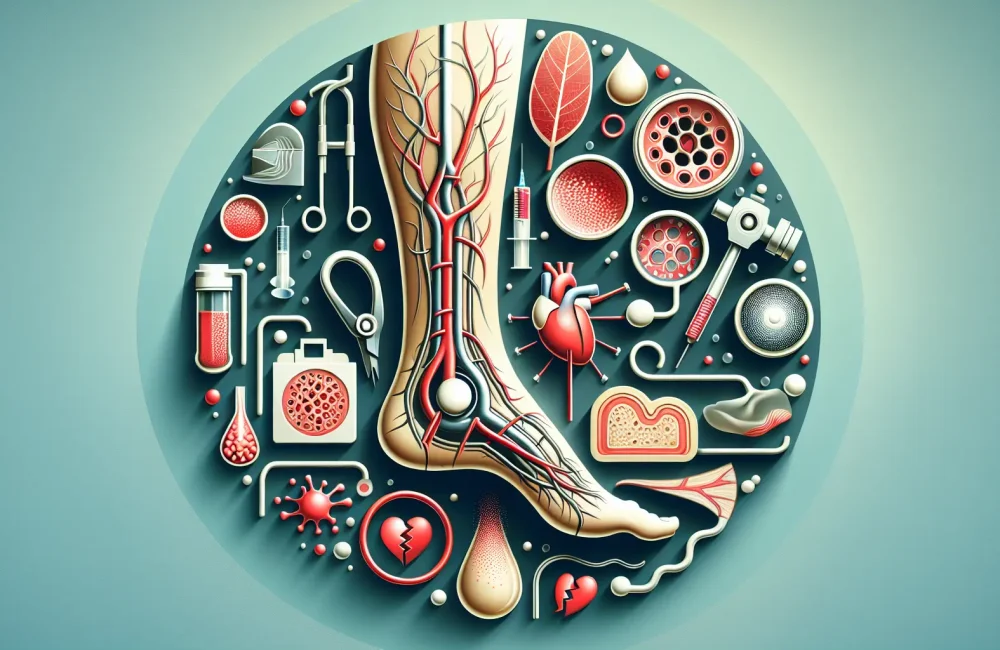By CAFMI AI From JAMA
Understanding and Diagnosing Chronic Venous Disease
**Pathophysiology and Clinical Presentation:** Chronic Venous Disease (CVD) of the legs is a widespread condition resulting from venous hypertension primarily caused by valve failure (valvular incompetence) and venous obstruction. This disturbance in normal venous blood flow leads to increased venous pressure, triggering inflammatory changes and tissue damage that manifest as symptoms ranging from mild leg discomfort to severe complications such as venous ulcers. CVD significantly impairs patients’ quality of life by causing pain, swelling, skin changes, and in advanced stages, non-healing ulcers.
**Diagnosis:** Proper diagnosis is critical for effective management. The clinical evaluation begins with a detailed patient history and physical examination focusing on the pattern of symptoms, visible signs such as varicose veins, edema, skin discoloration, and ulcer presence. Duplex ultrasound imaging is the gold standard diagnostic tool, enabling visualization of venous reflux and obstruction. This non-invasive technique helps clinicians understand the extent and location of venous pathology, guiding treatment decisions. Early and accurate diagnosis is essential to distinguish CVD from other causes of leg swelling and ulceration, such as arterial disease or lymphedema, which require different management approaches.
Conservative and Pharmacologic Management Strategies
**Initial Treatment Approaches:** The cornerstone of CVD management involves conservative therapies aimed at reducing venous hypertension and inflammation. Lifestyle modifications play a pivotal role, with recommendations including leg elevation to assist venous return, regular exercise to promote calf muscle pump function, and avoidance of prolonged standing or sitting. Compression therapy using graduated compression stockings remains the first-line treatment; these stockings exert external pressure to support venous valves, reduce venous distension, and alleviate symptoms such as swelling and pain.
**Pharmacologic Options:** When symptoms persist despite conservative measures, venoactive drugs can be considered. These medications work by improving venous tone, reducing capillary permeability, and exerting anti-inflammatory effects thus decreasing edema and discomfort. Examples include micronized purified flavonoid fraction and other plant-derived compounds, which have shown moderate symptom relief in clinical trials. However, pharmacotherapy should complement rather than replace physical therapies. Patient adherence to compression therapy and lifestyle changes is crucial for optimizing treatment outcomes.
Interventional Procedures and Long-Term Care Considerations
**Indications for Surgical and Minimally Invasive Interventions:** In cases where conservative management fails or when complications like recurrent venous ulcers occur, interventional procedures are warranted. Endovenous ablation techniques, including laser or radiofrequency ablation, have become preferred minimally invasive treatments to close incompetent veins effectively, offering quicker recovery and fewer complications compared to traditional vein stripping. Sclerotherapy, involving the injection of sclerosants to obliterate varicose veins, is useful for smaller or reticular varicosities. Surgical vein stripping remains an option for extensive varicosities not amenable to endovenous methods.
**Multidisciplinary Care and Follow-Up:** Optimal management requires patient education to ensure compliance with therapy and awareness of disease progression signs. A multidisciplinary approach involving primary care providers, vascular specialists, wound care nurses, and physical therapists can improve outcomes. Regular follow-up is necessary to monitor clinical response, assess for disease progression or recurrence, and adjust treatment plans accordingly. This long-term surveillance is especially vital to prevent ulcer recurrence and maintain improved quality of life.
**Clinical Implications:** For U.S.-based clinicians, individualized care plans considering patient comorbidities and severity of CVD should be integrated into primary care workflows. Prompt diagnosis, appropriate use of compression therapy, judicious pharmacologic treatment, and timely referral for interventional procedures are essential steps. Emphasizing patient education and lifestyle modification can substantially reduce disease burden and healthcare costs associated with CVD complications.
Read The Original Publication Here






